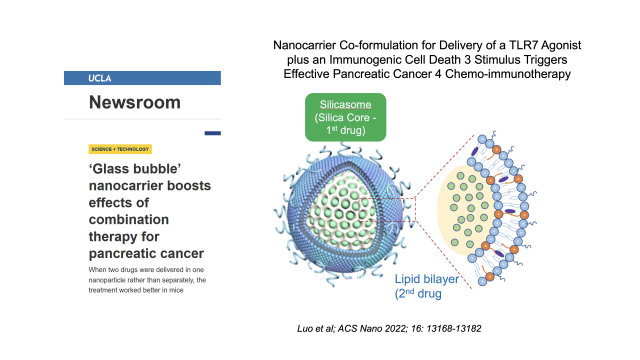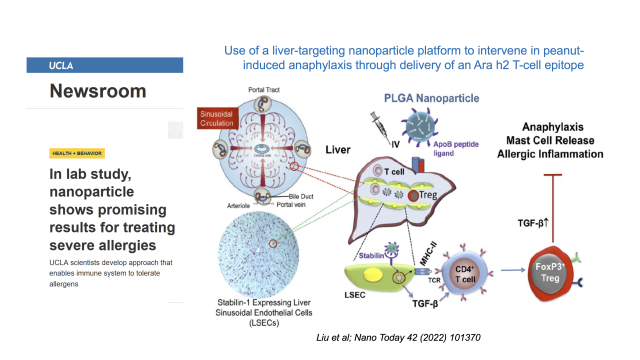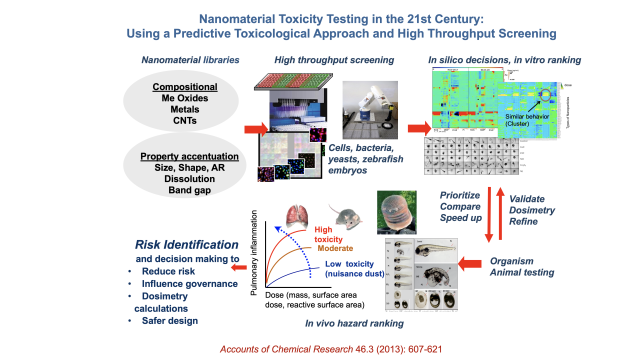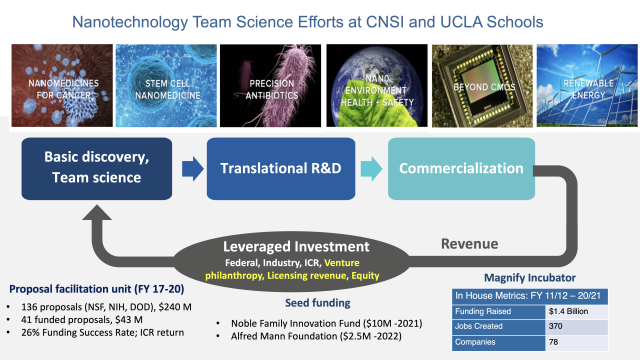About the Division
Nanomedicine Research Impact and Translation
Nanomedicine efforts launched by the division, include wide recognition for developing drug delivery systems for cancer chemotherapy, cancer immunotherapy, nanoparticle intervention in the immune system and launching biomedical applications based on high throughput discovery at the nano/bio interface. The major impact of the research into nano-cancer has been the development of a multifunctional mesoporous silica nanoparticle (MSNP) platform for chemo, siRNA and immune modulatory small molecule delivery in pancreatic and triple negative breast cancer. High content discovery also allowed customized design of a “silicasome” platform for effective drug delivery to treatment-resistant pancreatic cancer, resulting in improved chemotherapy and chemo-chemoimmunotherapy outcomes. The research efforts contributed to the filing of several US patents, some resulting in startup opportunities.
Another important research discovery relates to the use of nanocarriers for pancreas and breast cancer immunotherapy, premised on the use of synergistic drug combinations that convert “cold” immune environments to “hot”, in addition to preventing immune escape. The novel carrier design constructs include the development of prodrugs that can be incorporated into the lipid bilayer of MSNP, and liposomes. Several US patents have been filed and issued. Research into the safety and hazard of graphene oxide also elucidated the antibacterial use of this “2-dimensional nanomaterial”, resulting in the issuance of a US patent that permit graphene oxide use to prevent biofilm formation around indwelling catheters. This patent was recently been licensed by a startup company.

Through an understanding of how nanoparticles interact with the liver and reticuloendothelial system, an important recent research advancement has been that specialized antigen presenting cells in the liver can be targeted to generate tolerogenic immune responses that suppress food allergen anaphylaxis as well as the ability to intervene in autoimmune disease. Several US patents have been filed and are under consideration for licensing, including for preventative treatment of anaphylaxis, peanut allergy, and diabetes mellitus. More recently, the division has used its expertise in multi-epitope nanocarrier design to develop patent filing for new COVID vaccines, which are attracting interest from COVID vaccine manufacturers.

Research Impact of the Safe Implementation of Nanotechnology
Based on the successful competition for the UC Center for Environmental Implications of Nanotechnology (UC CEIN), the division of nanomedicine has played a prominent role in developing multidisciplinary team science efforts in CNSI and across the campus. UC CEIN was established in 2008 with a long-term vision of developing a multidisciplinary and quantitative framework for assessing the environmental, health, and safety impact of engineered nanomaterials. By focusing its screening efforts on emerging nanomaterials on their way to the marketplace, the center engaged in important discovery for guiding safe implementation of nanotechnology, including risk reduction and safe-by-design strategies. This was accomplished through pioneering efforts into high content screening of nanomaterials at molecular, cellular and organism nano/bio interfaces. These multidisciplinary team science efforts also became a blueprint for research operations in CNSI at large, allowing the division and CNSI to develop a Grants Facilitation Team to recruit and submit interdisciplinary applications to several federal agencies, with a 24% funding success rate in areas such as infectious disease/precision antibiotics, defense threat reduction, nanocancer therapeutics, vaccines, neuromorphic/PET/MRI imaging, and environmental implications of nanomaterials. Dr. Nel has also helped to establish seed funding opportunities, including chairing of the steering committee for the Noble Family Innovation Fund, which supports applications for high-risk/high-reward research, with exceptional translational potential.

NanoMedicine Contributions to the CNSI Interdisciplinary Mission Across Campus Proposal Facilitation Unit
The California nanosystems Institute (CNSI) is a hub of interdisciplinary research, translation, and education where scientists from diverse fields find common purpose in addressing grand challenges of the 21st century. The Division of NanoMedicine and UC CEIN contributed to the enterprise by launching team science efforts and a Proposal Facilitation Unit, which contribute to the CNSI mission to leverage public and private investment for nanoscience research at the interfaces between disciplines, translate discoveries into knowledge-driven commercial enterprises, and educate the next generation of scientists and engineers. At CNSI, engineers and oncologists create drug delivery systems to treat cancer. Chemists, physicists, and neurologists develop nanoelectronic sensors for mapping the brain. Environmental engineers and biologists use nanobiotechnology to clean pollutants from water. A few of our accomplishments towards federal and seed funding, revenue generation and output at the Magnify incubator is depicted at the bottom of the picture.

Teaching, education and EDI contributions
The division of nanomedicine trained 24 postdoctoral fellows in our research operations since 2008. Nine of our fellows have been appointed as professors, launching independent research careers at leading universities nationally and internationally. Over the course of 12 years, UC CEIN has graduated 39 PhD students across eight universities, almost all transitioning into careers in academia, industry, and policy. The division and UC CEIN also engaged in education and public outreach programs, introducing nanotechnology concepts to over 10,000 K-12 aged children through partnerships with the California Science Center, the Santa Monica Public Library, and UCLA’s Exploring Your Universe. In addition, the division contributed to the development of undergraduate, graduate and post-courses for students on the UCLA campus, including teaching in the toxicology program in the School of Medicine. The division's commitment, from inception, has been to ensure cultural, gender, racial, and ethnic diversity at all levels, emphasizing the importance of women and underrepresented minorities in shaping our research and outreach efforts. Among the 41 undergraduates working in our laboratories since 2017, 27 identify as women or underrepresented minorities. This includes participation by undergraduates from the UCLA student Research Program. Our researchers also participate in laboratory demonstrations for underrepresented minorities in the UCLA PEERS program.